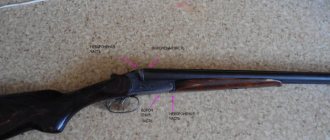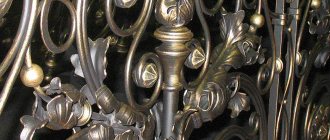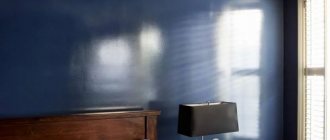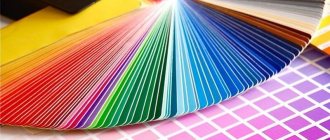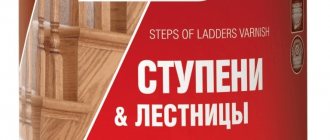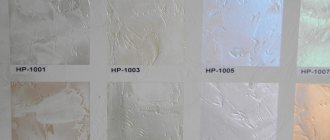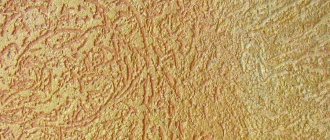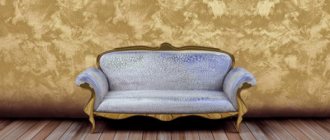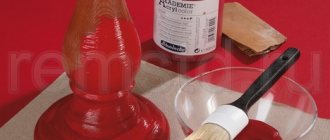What is patina and patination?
Natural patina is a film formed as a result of the oxidation of copper that appears on the surface of the metal. If you look at ancient monuments cast from copper, you can see a bluish-green coating. This is the patina that appears naturally under the influence of prolonged contact with air. This film perfectly protects the metal from corrosion. It can be seen on copper-containing alloys: bronze and brass.
In most cases, patina comes in various shades of green, but sometimes you can find a patina of blue, red, gray and even black.
Artificial patina is a coating that looks similar to natural, which is formed as a result of the action of special acids on the material. Patination is widely used in decorating interior items for:
- adding sophistication;
- noble antique appearance;
- increasing resistance to damage.
Artificial patina can be applied not only to metal, but also to any other materials - wood, leather, plaster. Modern formulations allow you to do this even at home. As a result, it is possible to achieve an “age-related” change in the color of the surface, while the internal structures of the material remain completely intact. An artificially aged object is practically no different in appearance from a genuine antique.
Features of processing large parts
The patination technology is slightly modified when working with large parts, such as door leaves, furniture facades, and wall panels. The preparatory stage is completely repeated without changes, but priming is carried out with a special primer, which is based on polyurethane or acrylic compounds.
When the primer dries, one thin layer of paint is applied. The part, completely dry after painting, is sanded with a metallized sponge called Scotch Brite. Then the surface is wiped dry and coated with a colorless polyurethane, acrylic or nitro varnish. The shade of varnish is selected based on the natural color of the wood being treated.
For birch, walnut and linden furniture, light, yellowish varnishes are used. For oak and alder, darker varnishes are used.
Patination of metal
Most often, patina is applied to metal products such as furniture fittings, barbecues, fireplace grates, decor for stairs and fences. An artificial patina helps prevent rust and gives the product an attractive appearance.
Before patination, the metal must be properly prepared. First, it is degreased with a rag moistened with alcohol or gasoline, then kept in a 10% solution of any acid. Usually metal brightens quickly. Then the product is washed and dried.
Aging of metal is performed in several ways.
1. Etching with special compounds
This method is suitable only for those who are familiar with chemistry and know how to work with chemicals. Each composition gives a specific color. For example, liver sulfur solution colors copper in various shades of gray.
2. Forge patina
This is the name of powder patina, which is diluted before work according to the manufacturer’s instructions. The most commonly used paint is gold, silver, and white. To work you will need a palette and synthetic brushes.
Process:
- Put some patina on your palette.
- Using a brush dipped in solvent, rub the paint.
- Continue rubbing until the brush is dry.
- Slowly apply the patina to the piece, touching the surface only with the tip of the brush. Strokes should be small and neat.
- Try to ensure that the coating is uneven so that abrasions are visible. Let the paint dry completely.
The process is quite labor-intensive, but the result will please you for many years. Tip: don't put too much paint on the brush, otherwise you'll ruin everything.
3. Potal
Potal is the thinnest foil sheets of metal that are literally glued to the surface of the product.
Patination with gold leaf is not difficult at all:
- Degrease the surface of the product and apply acrylic paint in two layers, let dry.
- Apply transparent glue for gold leaf and arrange the pieces of foil in the desired order, pressing them down with a brush.
- Wait for it to dry and coat with clear acrylic varnish.
Regardless of the method used for patination, it is imperative to clean the metal from uneven surfaces, dirt, and grease. To do this, it is treated with sandpaper, covered with putty and paint.
Materials for metal patination
Aging wood with your own hands by brushing
The method is simple, but not every breed is suitable for it. Spruce, larch, oak, and wenge have large fibers and the result will be impressive. Alder, cherry, birch, teak, on the contrary, are unsuitable for brushing due to their fine-fiber texture. Once you decide on the material, you need to prepare the tools.
You will need
- Hard wire brush.
- Abrasive brush or sandpaper.
- One of three coatings: varnish, wax, oil.
Sequencing
- Wet the item with water to avoid any wood dust during processing.
- Go over it with a wire brush, moving along the grain. A stiff brush will select soft fibers without damaging hard ones. The wood will become more prominent. The deeper the relief, the more aged the wood appears.
- Use an abrasive brush or sandpaper to clean the surface from burrs and roughness.
All that remains is to apply the coating and wait for it to dry. To enhance the decorative effect, you can paint the product in two colors. The grooves are in a light shade, the convex relief is in a dark shade.
What does a beginner need to know before starting work?
- Work in a ventilated area.
- Use safety glasses and a respirator, old clothes, and rubber gloves.
- Store chemical compounds in a glass container with a lid. Plastic or porcelain cuvettes can be used for mixing.
- If you are preparing an acid solution, remember: first pour in water, and then add acid.
- If the chemical gets on your skin, immediately wash it with running water, then moisten the area with a weak soda solution.
Burn the wood
Firing is in demand when you want to quickly age a material and you have the tools for the job at hand.
You will need
- Gas torch or blowtorch
- Wire brush
- Protective glasses
- Varnish
Instructions for firing without pre-treatment
Use a blowtorch or gas torch to quickly burn the product. Do not keep the tool in one place for a long time to prevent fire.
Brushed
- Pre-treat the surface with a wire brush, choosing soft fibers. This will give the wood the necessary convexity.
- Then burn at an accelerated pace, also avoiding fire.
Do not forget about safety glasses; they should be put on at the very beginning of work. When performing both methods, the final step will be the application of varnish.
Veneered plywood
Patination of wood - methods and possible effects
Patination is the artificial aging of the appearance of wood products, giving them a noble gilded or metallic appearance. Today it is used quite widely in the creation of luxury furniture, exclusive doors and windows, picture frames, etc. The furniture is similar to ancient examples of the Gothic style, the interior of the premises resembles a chic palace style. The patina looks especially impressive on relief wooden patterns and ornaments; some structural elements take on a real metallic appearance. If all technological operations are performed correctly and there is sufficient experience in performing such work, even real professionals can hardly distinguish between artificial patination and natural aging of wood.
The order of technological operations
You should not be afraid of a large list of operations; most of them have been familiar for a long time and do not require much time.
- Preparing the base. If you want to give wooden structures an even older look, you can use metal brushes to remove the soft layers of wood, which will enhance the impression of natural aging. There is a second way - simply sand the surface with large sandpapers or level the surface of the product with fine sandpapers. The choice of wood preparation method depends on the style in which you want to decorate your room and the purpose of the furniture.
- A primer must be applied to the prepared base; it is better to apply at least two layers. The primer will ensure more reliable adhesion of the patina, the coatings become more durable, and the risk of patina peeling as a result of changes in the relative humidity of the wood is eliminated. For the primer, you need to use a colorless polyurethane primer - its operational and physical characteristics are optimally combined with the patination technologies used. One more thing. It is advisable to wipe the first layer of primer a little with sandpaper - the smallest scratches will significantly increase the quality of the connection of the second layer of primer with the first.
- The primer also needs to be sanded a little in order to increase the adhesion of the patina to the primer. After this, you can begin applying the patina. The color of the patina should be selected taking into account the final style of the furniture, and it is better to try the achieved effect on several unnecessary sections of the board. The fact is that it is theoretically impossible to take into account all the nuances; even very experienced craftsmen always try to make a test before performing the main volume of work. Only practice can reveal all the characteristics of wood and the compositions used for patination.
- Patina treatment. After the coating has completely dried, you can begin processing the patina coating. There are two ways here - in some cases, remove a thin layer of coating using metal sandpapers, or cover the patina a second time with darker colors with a semi-dry brush. Both methods give good final quality; the choice depends on your skills and preferences. The second method, by the way, can give patinated surfaces additional relief.
- The final stage is a finishing coat with clear varnish. The coating is carried out using conventional technology; there is no need to invent anything new.
We have talked about the general patination technology, now we should talk about the features and the most used methods.
| Types of patina |
First way
It is considered the simplest, used by inexperienced craftsmen, and in terms of quality, strange as it may seem, it gives quite acceptable results. A thin layer of patina is applied to the prepared surface with a brush; after drying, the patina is sanded with a special metal sandpaper or a metal brush. In terms of color, the patina should be used a little darker than the product has.
| Patination of doors |
Second way
The so-called contrasting patination is used in combination with the first method. The purpose of such patination is to separately highlight existing three-dimensional patterns or ornaments on a wooden surface. Milled or hand-carved designs are covered with a patina in the color of gilding or silver; in some cases, an ordinary dark patina can be used. The compositions should be applied only to the drawings; work can be done with a brush or sponge; the patina should be thoroughly rubbed into the elements of the relief drawings. It is better to do final varnishing with matte varnishes; glossy varnishes can neutralize the resulting effect.
| Patinated frame |
Third way
The most complex, but also the most effective, is used for expensive models of luxury furniture. To improve the aging effect of the patina, craquelure is used - a special composition that causes natural cracks in the finishing coatings. Craquelure varnish is applied directly to the primer, and the patina is applied to it. As a result of complex chemical reactions, the patina layer receives cracks in various directions, and this visually ages the surface of the product even more.
Sometimes the crackle technique is used, followed by patination grout. This method requires applying two layers of craquelure varnish; the second layer of varnish must be applied to the first layer that has not completely dried. The depth and length of cracks in the patina depends on the thickness of the applied varnish. To make the cracks even larger in size, you can use a heat gun to speed up drying. After complete drying, you need to rub special grout of golden, bronze or silver colors into the cracks; the excess is immediately removed. To dry the parts, leave them for at least a day in a warm, well-ventilated area. The final stage is covering the surface with transparent varnish in several layers.
This patination is best used only in some parts of the product, usually in the corners. If you treat the entire surface, the results may disappoint you. There are several more very complex patination methods, but they are used only by highly qualified museum restorers; for ordinary furniture manufacturers, these technologies are unattainable for many reasons.
| Patina with craquelure varnishes |
← Use of second-grade lumber in construction Staircase made of veneered plywood onto a metal frame →
We recommend watching:
Plywood FC | 4mm | 1520 mm x 1520 mm | birch | construction | NS
350 rub.
Plywood NEEDLES | 12mm | 1220 mm x 2440 mm | coniferous | grade SM | NSH(PRICE ON REQUEST)
RUB 1,550
Plywood FSF | 9mm | 1220 mm x 2440 mm | birch | grade 2/3 | Ш2
RUB 1,800
Plywood FC | 12mm | 1520 mm x 1520 mm | birch | grade 4/4 | NS
960 rub.
Plywood FC | 9mm | 1520 mm x 1520 mm | birch | grade 2/3 | Ш2
950 rub.
Plywood LAMINATED FOF | 4mm | 1500 mm x 3000 mm | birch
RUB 2,200
Plywood NEEDLES | 21mm | 1220 mm x 2440 mm | coniferous | grade SM | NSH(PRICE ON REQUEST)
RUB 2,450
Plywood FC | 18mm | 1520 mm x 1520 mm | birch | construction | NS
RUB 1,320
Plywood FSF | 18mm | 1220 mm x 2440 mm | birch | grade 4/4 | NS
RUB 2,300
Plywood FSF | 10mm | 1500 mm x 3000 mm | birch | grade 3/4 | Ш1
RUB 2,450
OSB | 8mm | 1250 mm x 2500 mm
540 rub.
OSB | 18mm | 1250 mm x 2500 mm
1,200 rub.
Plywood FSF | 6.5mm | 1500 mm x 3000 mm | birch | construction grade | NS
RUB 1,350
Plywood FSF | 18mm | 1220 mm x 2440 mm | birch | grade 2/3 | Ш2
RUB 2,600
OSB | 22mm | 1220 mm x 2440 mm
RUB 1,450
Plywood FC | 21mm | 1520 mm x 1520 mm | birch | grade 3/4 | Ш2
RUB 1,950
Plywood FSF | 4mm | 1220 mm x 2440 mm | birch | grade 3/4 | Ш2
800 rub
OSB | 15mm | 1250 mm x 2500 mm
1,000 rub.
Plywood LAMINATED FOF | 9mm | 1500 mm x 3000 mm | birch
3,000 rub.
Plywood FSF | 15mm | 1220 mm x 2440 mm | birch | grade 3/4 | Ш2
2,000 rub.
Comments
No one has left a comment yet

